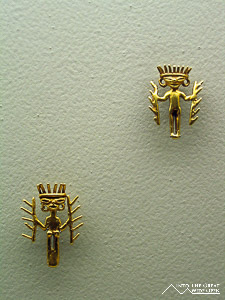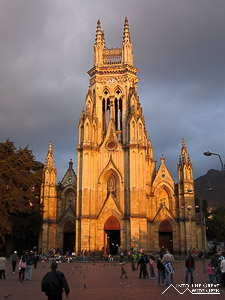Bogota, Colombia
Bogota Part I
December 31, 2007
Destruction leads to a very rough road
But it also breeds creation
- Red Hot Chili Peppers

The first day after I arrived in Bogota I hiked up to Monserrate, the church on a mountain that borders Bogota to the east. Considering that Bogota itself is at an altitude of about 8,300 ft, it was quite taxing, especially after spending more than a day sitting on a bus. The pathway up to the top was buzzing with activity since it was the last Sunday of the year and many people were making the pilgrimage to the church. The trail was essentially one continuous market with one stall after another on the spiraling stone pathway. It took about an hour to walk the stone steps all the way to top, which is at an elevation of about 10,000 ft. At the top there were great views of Bogota as it sprawled away from the hills in all directions.

After lingering at the top for a while I decided to head back down to the city. The alternative to walking up to the top was to take either the cable car or the old railroad. Of the two, the cable car seemed much more terrifying so I opted for that. With the maximum number of people crammed into the cable car we began plummeting nearly straight down towards the base of the mountain, reaching the bottom in a few minutes, definitely a lot quicker than walking and much easier. Following my visit to Monserrate I went to the Museo del Oro to the see the collection of gold artifacts. When I got to the museum there was a sign posted saying that the museum was closed for renovations until 2008 and a few of the most important pieces has been moved to another museum across the neighborhood. I visited this other museum and the few gold pieces that were there were really nice, but the selection was quite limited.

I continued walking through the historic district, La Candelaria, and looked at some of the churches and other buildings. The road was closed in front of the presidential palace and armed guards were walking up and down the sidewalk. When I stepped onto the sidewalk to take a picture the guard told me that I wasn´t allowed to walk on the sidewalk. I was a bit perplexed and I think that was the first time I had been told to walk in the street rather than on the sidewalk. I spent some more time wandering around the city before taking the Transmillenio, Bogota´s mass transit system, back to my lodgings. The Transmillenio is a bus system that runs in special lanes in the middle of the road along selected routes. It is really convenient for the parts of the city that it serves, although it is rather confusing as there are all sorts of different continuing routes marked by different letters and colors and these are interspersed with both normal and express buses to add to the confusion.

The next day I attempted to go to Zipaquira, the underground salt cathedral located an hour north of the city. After a 20 minute Transmillenio ride and another hour on a local bus, followed by a 15 minute walk through town to find the place, I got there around 1pm only to find that they had closed at noon because it was New Year´s Eve. Apparently no one else knew either because there were lots of cars filled with Colombian tourists also trying to get in. Despite the long process involved in getting there I decided that I would have to come back the next day to see it, after all, it is one of the unique attractions in Colombia.

Following several days in the city I have to say that Bogota seems to have a pretty good climate. Due to the elevation it is warm during the day, in the 70s (F) with a strong sun, and cold at night, sometimes down near freezing. I haven´t experienced the rains that are apparently common but other than that it seems quite pleasant and something that I could get used to.

































































